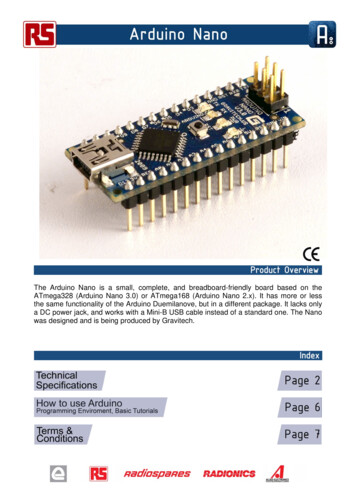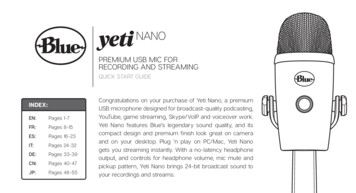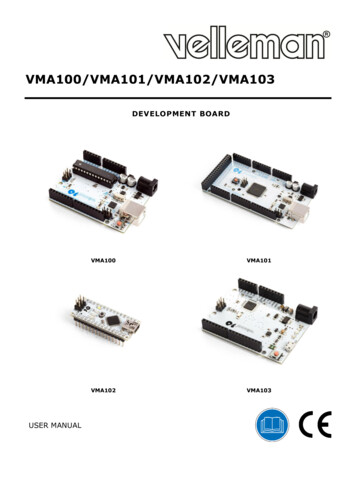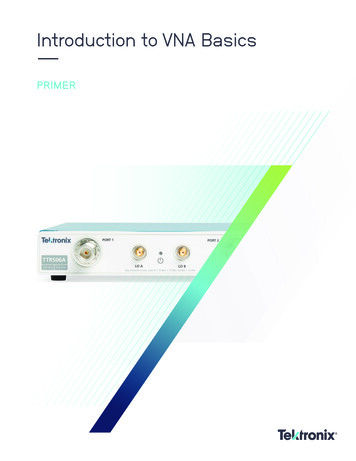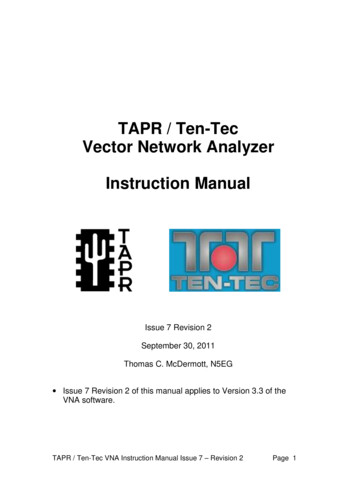
Transcription
NANO VNA’S FORBEGINNERSBy: Jim-KA6ETEjim@ka6ete.comwww.ka6ete.com
Basic Functions of the Nano VNAfor Amateur Radio OperatorsStanding Wave Ratio (SWR)Return Loss in dB’sLine Loss in CoaxLength of CoaxResonate FrequencyFrequency Range of AntennaAntenna and Coax ImpedanceBy: Jim-KA6ETE
CalibratingtheNano VNA forAntenna and CoaxTestingTop:Homemade Calibration Standards:The 50ohm Load is a true 50.08 ohmsCalibration is quick and easy to preformand should be done for each use and eachband being tested.Bottom:Supplied Calibration Standards:Due to quality of manufacturerthey can vary in readings. Varyingfrom 44.6 ohms to 57.3 ohmsfrom the ones I tested.
CalibrationStep 1:Power on the Nano VNA and tap the upperright corner of the screenNext tap on the CAL button, followed by theCALIBRATE button
CalibrationStep 2:Using the extension cable you will be usingfor DUT (Device under Testing) connect it tothe “CH 0” of the Nano VNA and the OpenStandard.Tap the “OPEN” buttonThe optimal calibration would be to use allconnectors needed to connect to the DUT forcalibration but using as many pieces aspossible will lower the chance of a falsereading.
CalibrationStep 3:The next step is to attach the jumper cableto the “SHORT” Standard and press the“SHORT” button on the Nano VNA.
CalibrationStep 4:In step 4 of the Calibration sequenceconnect the jumper cable to the “LOAD”Standard and press the “LOAD” button onthe Nano VNA.At this point your Nano VNA is ready to testantennas and Coax and you can now pressthe “Done” button on the Nano VNA.
TestingSWR on anAntennaPress “Stimulus” to set theStart Stop Frequencies.When doing this you can first disable all butone of the “Traces” is desired. Step 1: Power on the Nano VNA andcalibrate if it is not already completed. Step 2: Set the Start and Stopfrequencies for the Band or section ofband you want to test. Step3: Connect the antenna to be tested.Enter the frequencyaccordingly, in eitherkHz, MHz or GHz.
TestingSWR on anAntennaOnce the antenna is connected make surethe connection is tightened properly andsecure. Step 4: Select the Trace you want touse under the “Trace” Step 5: Select the Format you want totest such as SWR under the “Format”label.Now that your results are displayedyou can press and drag the markericon to change the frequency withinthe range you selected. Thefrequency in which the marker is onwill be displayed in the upper rightcorner of the display.
Connecting to a PC or TabletWhile the Nano VNAcan be used as astandalone device,connecting to a tabletor PC via additionalsoftware can beeasier to utilize all thefeatures the NanoVNA has to offer.
NanoVNA-Saver vs. NanoVNA-SmartWhile both programs an improvement in display capabilities over the screen on the Nano VNA, it is personalchoice on which to use.NanoVNA-SaverNanoVNA-Smart
NanoVNA-SaverNanoVNA-Saver is an opensource Python3.7/QT program available for download onGitHub sThis is also the software package I use withboth my desktop PC and windows 10 tablet.Additional Resource Links: na/ m ge-1/
Testing anDual-bandAntennaWith being limited to 101 points on the NanoVNA it can make reading the charts moredifficult when sweeping multiple bands. Asseen in the image on the right whensweeping 140.000 MHz thru 450.000 MHz.
Testing anDual-bandAntennaReducing the sweep span greatlyincreases the detail of the graphs as seenon the right. This is sweeping 144MHz to149MHz.
Time-DomainReflectometer(TDR)An additional feature that the Nano VNA iscapable of is giving the estimated length of thecoax cable. This feature is only available whenconnected to a PC or Tablet and for the mostaccurate estimation you MUST calibrate theNanoVNA to the frequency being swept.**The physical measurement of the coax is 77’ 10.5”.**
Additional Resources: Coax loss calculator: www.kv5r.com NanoVNA-Saver Download: https://github.com/mihtjel/nanovnasaver/releases Linux Platform Help: na/ NanoVNA-Smart ftware.htm Additional videos and help: age-1/ Forum Group at Groups.io: https://groups.io/g/nanovna-users/topics
TheEndNANO VNA’S FORBEGINNERSBy: Jim-KA6ETEjim@ka6ete.comwww.ka6ete.com
With being limited to 101 points on the Nano VNA it can make reading the charts more difficult when sweeping multiple bands. As seen in the image on the right when sweeping 140.000 MHz thru 450.000 MHz. Testing an Dual-band Antenna Reducing the sweep span greatly


